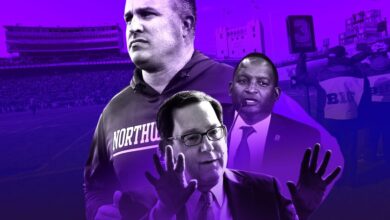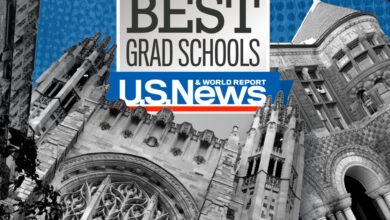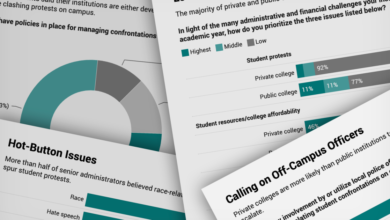A Bright Spot for Enrollment Is Showing Signs of Strain

[ad_1]
Graduate-student enrollment has been a rare bright spot for higher education in recent years, as the number of undergraduates has declined. But a new analysis suggests that institutions’ increasing reliance on graduate admissions is based on unrealistic targets, and is putting strain on the staff members who recruit for these programs.
Nearly half of graduate-enrollment professionals are considering leaving their posts, according to a new report from EAB and Nagap: The Association for Graduate Enrollment Management. The reasons for that, the paper finds, are clear: Increased workloads for understaffed departments. Just about every department in higher ed is coping with similar challenges, but people working in graduate enrollment are facing distinct frictions.
For one, graduate enrollments have experienced healthy growth across higher ed during the pandemic, with year-over-year increases of 2.4 percent and 2.1 percent in 2020 and 2021, respectively, EAB/Nagap estimated. But that enrollment bump hasn’t been spread evenly across the sector — in fact, one in three institutions saw declining graduate enrollment between 2019 and 2020. And recent data signal a softening in demand: The National Student Clearinghouse Research Center observed a nearly 1-percent drop in enrollment in graduate and professional programs this spring from the previous year.
Amid the pandemic, dozens of doctoral programs opted to suspend admissions for a year, forgoing an incoming class in the fall of 2021 in order to devote money to already-enrolled students. But with those programs back to accepting applications, many institutions are looking to graduate enrollment to help compensate for the larger drop in undergraduate enrollment: A full 47 percent of EAB’s respondents noted an “enhanced reliance” on graduate programs to pick up the slack.
That increasing reliance, combined with well-documented pandemic-era staff shortages, means more stress on graduate-enrollment staff members, Pam Kiecker Royall, EAB’s head of enrollment-services research, said in an interview. Nearly half of all respondents, 49 percent, said they were “extremely” or “very” stressed at work. The eight flash polls EAB and Nagap conducted between September 2020 and March 2022, on which the report is based, revealed that institutions have been “stretching the expertise of the enrollment professionals that were in particular roles to cover more, and sometimes expand beyond their portfolio, and as such, beyond their comfort level,” Royall said.
An ‘Unsustainable’ Situation
All of that stretching, on top of the increased demands, has led to stress. In general, Royall said, graduate-enrollment officials are questioning whether the goals they’re being asked to meet are attainable. “It was already challenging to do X,” she said. That’s prompted enrollment officials to ask, “Why did they have to do X plus Y plus Z?” Twenty-nine percent of the 1,216 people from 790 institutions who participated in the flash polls said unrealistic goals were a factor in their work stress.
Those enrollment officers might be trying to sell students on new hybrid or virtual degrees, or programs whose curricula were overhauled during the pandemic, Royall said. And the data show that they are also ramping up their promotional efforts. Two-thirds of EAB/Nagap survey respondents said they’d beefed up marketing efforts in 2021, including by adding or increasing virtual events and personalized outreach by faculty and staff members.
Such efforts aren’t just one-time ways of combating a lack of in-person interaction during the pandemic, respondents indicated. Instead, they’re becoming “the new status quo for how you recruit graduate students,” Royall said.
Graduate-enrollment staff are also pitching their institutions to more students of color — more than half of respondents said increasing racial and ethnic diversity was a priority for their institutions in 2021. There has been some progress in that realm; EAB/Nagap’s analysis of federal data found that 10-percent more Hispanic or Latina/o students, 8-percent more Asian students, and 5-percent more Black students had enrolled in graduate school in the fall of 2020 than in the fall of 2019. But demand for those students is high, and enrollment officers must contend with equally high expectations from administrators to recruit them. “When everybody else is trying to convert or recruit for diversity,” Royall said respondents wondered, “why are my goals now so extreme when we know it’s a difficult environment?”
Taken together, it’s not a pretty picture for graduate-admissions offices. There’s pressure to either maintain high enrollment or raise flagging head counts, and there are more ways to do so, through targeted and virtual outreach, and fewer people on the payroll to make it happen. Perhaps it’s not a surprise, then, that 46 percent of the EAB survey respondents said they were considering leaving their current roles, 14 percent of them for a position outside higher ed. Nor are only mid-career and senior graduate-admissions officers considering career moves, Royall said. Junior staff members are “leaving higher education for something else in numbers that seem unsustainable.”
[ad_2]
Source link






